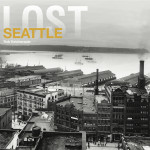Roy Lillico
The life story of Roy Lillico reads like a Jack London romance, with the locale transposed from San Francisco to Puget Sound, for Mr. Lillico, from his young boyhood days has been constantly in and on the waters of the Sound, advancing from rowboats to seagoing tugs.
Born in Canada, province of Ontario, November 9, 1882, Roy Lillico is the son of Peter and Rachel (Eggelson) Lillico, and came to Seattle with them on November 1, 1889, five month after the Seattle fire. His father successfully engaged in the real estate and loan business in the rapidly growing town. Both parents are deceased. Young Roy attended school at the Denny, the Central and the Columbia (now Lowell) schools. Out of school hours and during vacations he worked up a business of pulling boats to the ships in the harbor, from every nation in the world. Also, he furnished the ships with ship chandlery and stores and on finishing his schooling devoted all of his time to this work, outfitting as many as one hundred and twenty-six vessels on Puget Sound in one season. As a boy he knew every ship that made the various ports and he was likewise known to the officers and crews of the different ships, for his was one of the first hails that came over the bow of the ship as it entered the harbor and the last to see them leave when he rowed the captain to his ship and well remembers the chanteys when pulling up anchor. Young Roy was also the motive power for the port of Seattle’s official customs house launch, rowing the two officials out to every foreign craft entering the harbor, and he also rowed the harbor master to welcome incoming naval ships of the old white navy. As the only way of getting word to the ships in the harbor was to send it out in a small boat, he soon became a courier for the shipping concerns. These were the days of the White Hall ships.
In his capacity as supplier of stores, Mr. Lillico once furnished five hundred loaves of bread a day and other stores to the U. S. S. Mohegan while it was in the Sound testing Puget Sound and British Columbia coal for the United States Navy. Later he was on the Mohegan when that vessel, the last of the wooden vessels of the navy, first visited the present site of the navy yard at Bremerton. He also ran the lines for the first Nippon Yusen Kiasha boat to come here from the orient, the Miki Maru, landing at the old Schwabacher dock.
Mr. Lillico furnished supplies for the U. S. S. Monterey, the last of the monitor type of war ship, at the time it tested out the new drydock at Bremerton; and he remembers the arrival of the Portland from Alaska with the “ton of gold ;“ the departure of horse transports from here to the Philippines during the Spanish-American war and the amazing amount of food he had supply them; when cement was brought from Belgium; Port Blakely, now a quiet summer resort, when that town harbored the largest lumber mill in the world and as many as eighteen or twenty boats were loading at one time; the races between the Bailey Gatzert, the T. J. Potter and Olympian sternwheelers and sidewheelers and the track boats of Puget Sound from Seattle to Tacoma; when Eagle Harbor had a small gasoline launch, the Dewey, as the only mode of travel between there and Seattle; and hundred and one other interesting and amusing incidents of early days.
When tugboats came into use, Mr. Lillico added them to his line, as he soon did lighters, car ferries and later water taxies. At the same time he organized the Lillico Tug & Barge Company, the Lillico Transportation Company, and the Harper Barge & Lighterage Company, serving as president of all three. His business has grown so gradually, as the shipping interests of the harbor have grown, that he is regarded as an integral part of the ships and shipping of the northwest and his acquaintance is worldwide.
The marriage of Roy Lillico, occurring May 26, 1904, at Olympia, united him with Lucy Young, a native of Astoria, Oregon, a daughter of Waldo and Clara Young. Mrs. Lillico is prominent in club and educational circles in the city as a member of the Century Club and the Broadway Orthopedic Guild. She is president of the Broadway High School Parent-teacher Association and a member of the Seattle high school council. Three children have blessed the union of Mr. and Mrs. Lillico; Stuart Plimpton, a graduate of the Broadway high school and now attending the University of Washington; Adrienne Louise, attending the Broadway high school; and Helen Beatrice, a student the Lowell school.
Mr. Lillico is a member of Seattle Lodge, No. 92, B. P. 0. E., and is independent in politics, though favoring republican doctrines. He is a member of the Press Club and vice president of the Denny School Alumni Association. He has served on executive board of the Boy Scouts and on committees of the Merchants Exchange and the Chamber of Commerce and is on the naval affairs committee of the last named body. He was on committee the that started the first (white) Potlach in Seattle. It is interesting to record the reminiscences of these men who have lived through the pioneer period of the water front days for their posterity to read and realize that the early days were not filled with conveniences of this period and it has been the work of editor of this history to save what has been possible to remember and from clippings that the younger generations will have data to build on for the future histories.
Posted by Rob Ketcherside at July 17, 2005 3:23 PM